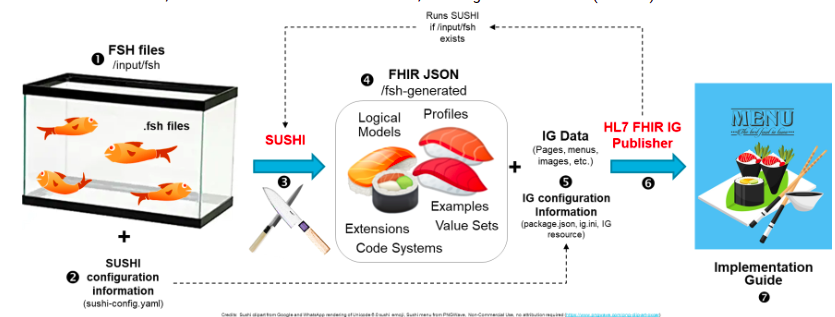Fhir Implementation Guide Document
Quik Links
Where To Go :
- Install SushiTo install Sushi:
First install Node.js LTS from https://nodejs.org/en/download/ - Open your terminal and run this command :
npm install -g fsh-sushi See more details here https://fshschool.org/docs/sushi/installation/- Tools used for writing implementation guides include.
- Forge: This is used for building fhir data model and building profiles, extensions, However, Forge client is good for windows Pc, you can also use forge using the command line. For more instructions follow this link https://docs.fire.ly/projects/Forge/InstallingForge.html.
- Trifolia: Getting an over view with this tool https://trifolia-fhir.lantanagroup.com/lantana_hapi_r4/home.
3. Sushi: https://github.com/FHIR/sushi.
What is Sushi
SUSHI (an acronym for "SUSHI Unshortens SHorthand Inputs") (4) is a reference implementation of a FSH compiler that translates FSH into FHIR artifacts such as profiles, extensions, and value sets. SUSHI is installed on your own computer and runs locally from the command line (Reference).
Here's one illustration, both obvious and somewhat obscure, showing how this works! (Citation)
Fhir Terminologies
Logical Models In Fhir: One of the capabilities that have been added to FHIR reasonably recently is the capability to use the conformance infrastructure (like StructureDefinitions, ValueSets etc) to produce logical models – rather than defining resource types and such like.
The purpose of the logical model is to gather requirements from clinicians and other folk that can subsequently feed into the design process for profiles and Implementation Guides. While it’s possible to create profiles directly during this process (and one of the goals of FHIR is to support this) – there’s no doubting that it does require some understanding of FHIR and the structure/purpose of the existing resource types, so the Logical Model ‘bridges the gap’ by documenting the requirements in a computable fashion without placing any constraints on the model structure.
So the overall flow from the requirement to the Implementation Guide would be as follows:
- Building the Logical Model. This requires significant interaction with the clinical and openmrs fhir2 refinement of the model, but should require minimal knowledge of FHIR ( like an understanding of the datatypes). An output of this stage would be the Logical Model and the ValueSets required (or at least their identification).
Generate the Implementation Guide that has all the FHIR artifacts such as Profiles and the ones generated in the first step (e.g. ValueSets).
Here is the Table of local Model.
Here is the vedio showcasing fhir ig
